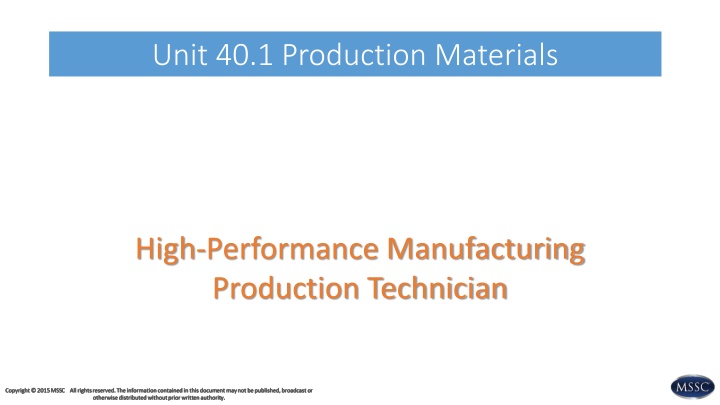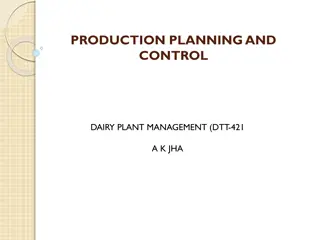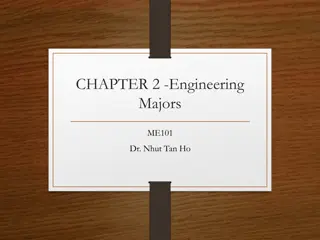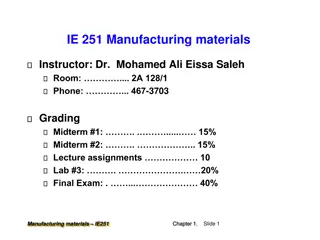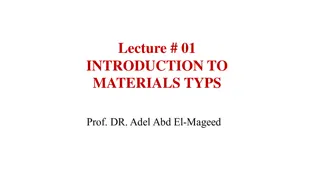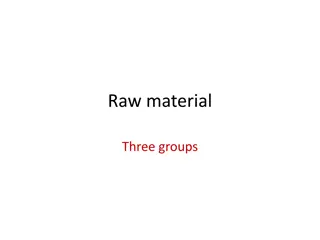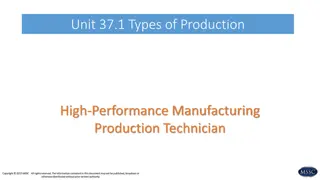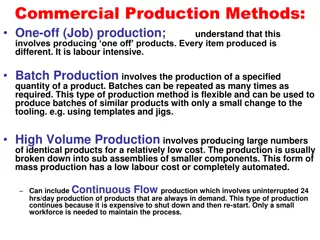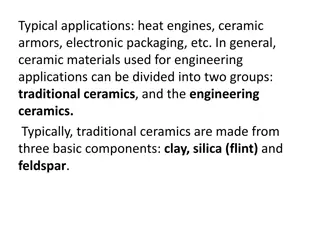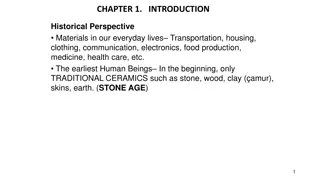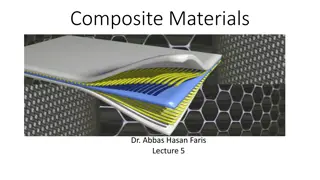Engineering Materials and Production Techniques Overview
Learn about the various types of engineering materials used in high-performance manufacturing, including natural and synthetic materials. Explore the properties of materials, such as strength, conductivity, and resistance. Discover the different categories of metals, alloys, and polymers commonly utilized in production processes. Gain insights into the importance of material selection and the fundamentals of powder metallurgy technology. Dive into the world of materials science and enhance your understanding of material properties and applications.
Download Presentation

Please find below an Image/Link to download the presentation.
The content on the website is provided AS IS for your information and personal use only. It may not be sold, licensed, or shared on other websites without obtaining consent from the author.If you encounter any issues during the download, it is possible that the publisher has removed the file from their server.
You are allowed to download the files provided on this website for personal or commercial use, subject to the condition that they are used lawfully. All files are the property of their respective owners.
The content on the website is provided AS IS for your information and personal use only. It may not be sold, licensed, or shared on other websites without obtaining consent from the author.
E N D
Presentation Transcript
Unit 40.1 Production Materials High-Performance Manufacturing Production Technician
ENGINEERING MATERIALS Material Sources A production material is any material used to make another material or product. Production materials can be natural or synthetic. Natural Material A material that occurs naturally, such as wood, rock, iron ore, and animal hides. Synthetic Material A material that does not occur naturally but is a result of a chemical process that combines natural and sometimes other synthetic materials.
ENGINEERING MATERIALS: cont. Raw Materials Those materials that come from the earth, the water, or the air. Engineering Materials Materials that have a solid structure and hold their size and shape under normal conditions. Recycled Materials Used materials that are reprocessed and used again.
ENGINEERING MATERIALS Material Properties Strength Tensile strength Torsion strength Electrical conductivity and resistance Appearance Brittleness Hardness Ductility Malleability Elasticity Corrosion resistance Thermal conductivity and resistance Melting point Flammability
ENGINEERING MATERIALS Metals Produced in standard stock of sheets, bars, and rods of various sizes and shapes. Metal Types & Uses Natural metals Metals include iron, copper, aluminum, and chromium, lead, gold, and silver. Alloy A controlled mixture of two or more metals or of a metal and a nonmetal. Categorize as ferrous, nonferrous, and powdered. Ferrous Metals Metals containing iron. Nonferrous Metals Contain little or no iron.
Metals Handouts Metals and Nonmetals Periodic Table Short History of Metals
ENGINEERING MATERIALS cont. Powdered Metals Can be ferrous, nonferrous, or a combination Polymers Substances composed of very large molecules Wood and rubber are natural Plastics are synthetic Wood Strength A grain, or pattern Moisture absorption Flammability and vulnerability
Metal powder and powder metallurgy technology https://www.youtube.com/watch?v=O7U4HWjYcqo Polymers - Crash Course Chemistry #45 https://www.youtube.com/watch?v=rHxxLYzJ8Sw Manufactured Wood Products https://www.youtube.com/watch?v=-dcUw9FYMI4
ENGINEERING MATERIALS cont. Textiles & Leather Can be natural, synthetic, or a mix of the two. They are made of fibers that are woven together into fabric. Leather is a natural material Plastics Manufactured polymer substances that are liquid or moldable during processing but are solid as a final material. They are relatively inexpensive, readily shaped, molded, and machined. History of Plastics Handout DIFFERENT TYPES OF PLASTICS CLASSIFICATION Handout
ENGINEERING MATERIALS Elastomers (handout) Shapeless polymeric material Rubber is a natural elastomer Can be produced synthetically from a petroleum source Ceramics (handout) Glass Clay Abrasives Refractories Cements Advanced Ceramics (handout) Piezoceramics Bioceramics Glass microspheres https://www.youtube.com/watch?v=tETmA-LNyVI
ENGINEERING MATERIALS Composites The combination of two or more distinct types of materials to create a new, superior material that has properties that original materials do not have. Finishing Materials Used to coat and preserve wood, metal, plastic, and other materials or to decorate a product or make it more durable.
ENGINEERING MATERIALS Wood Finishes Paint, lacquer, varnish, oil, and wax Metal Finishes Lacquers and enamels Coating of oil Metal plating Web Search: What are types of metal finishes? Name some ways of preventing metal corrosion?
Knowledge Quiz Knowledge Quiz Questions: 1. Name the difference between ferrous and nonferrous metal. 2. Finishing material such as paint serves what purposes? 3. Name three properties of engineering materials. 4. Fiberglass is considered a composite, why? 5. Synthetic wood products has many uses. What synthetic wood product is made of veneers.
CHEMICALS, FOSSIL FUELS & FOOD Chemicals Chemical Sources Mined minerals Petroleum and other fossil fuels Chemical Types & Uses Industrial chemicals are chemicals produced in large volume in chemical processing plants Specialty chemicals are chemicals produced in much smaller quantities
CHEMICALS, FOSSIL FUELS & FOOD Industrial chemicals Organic chemicals Benzene Methanol Ethylene Inorganic chemicals Sulfuric acid Chlorine Sodium hydroxide Active pharmaceutical The active ingredient, intended to address a particular medical problem Nutraceuticals Foods or food supplements
CHEMICALS, FOSSIL FUELS & FOOD Fossil Fuels Fuels formed deep in the earth from plant or animal remains Petroleum To make gasoline, methane, propane, benzene, and chemicals used in plastics Food & Beverages Processed foods and most beverages made from either plants, animals, or some combination of these natural sources
Knowledge Quiz Knowledge Quiz Questions: 1. Chemical use in manufacturing food and beverages do what? 2. Fossil fuels play a large role in manufacturing chemicals, why is that? 3. An active pharmaceutical does what?
Apply Your Knowledge Web Search: Your favorite soft drink What are some of the ingredients and chemicals in it? Create a flow chart
This course is 100% funded by the MoSTEMWINs $19.7 million grant from the U.S. Department of Labor, Employment and Training Administration (TAACCCT). The product was created by the grantee and does not necessarily reflect the official position of the U.S. Department of Labor. The Department of Labor makes no guarantees, warranties or assurances of any kind, express or implied, with respect to such information, including any information on linked sites and including, but not limited to, accuracy of the information or its completeness, timeliness, usefulness, adequacy, continued availability, or ownership. This MoWINs product was created by North Central Missouri College and is licensed under the Creative Commons Attribution 4.0 International License
